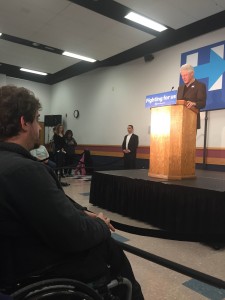
Washington, Jan. 23 – In an appearance for his wife, former President Bill Clinton told the crowd he loves Iowa because people are not afraid to tell him exactly what to do.
Most recently, he recounted a story with an individual who commended him for getting a law changed while president “that said people with disabilities could go to work and still keep their Medicaid coverage.”
Speaking in Marshalltown, Iowa on Jan. 15, Clinton called it a “win-win deal.”
“If you have $100,000 in medical bills to maintain your condition every year, why take a $30,000 job? But if you take the $30,000 job you’ve got something to do, you’re contributing to the economy, you’re paying into Social Security, you’re paying into Medicare.”
In this conversation, Clinton said, he was told the importance of doing the same thing for Social Security Disability Insurance, which is currently an all or nothing benefit. “For people with genuine disabilities, we need a sliding scale,” Clinton said.
Presidential hopeful Hillary Clinton recently said the same thing.
“We shouldn’t have an immediate cut off,” she said in an exchange with The RespectAbility Report in Osage, Iowa on Jan. 5, the same day she announced her Autism plan. “If you go to work you shouldn’t be cut off of SSDI.”
Earlier this month, Hillary Clinton announced a plan calling for public-private partnerships to help young adults with autism become employed.
“What the employer needs to do is to simply design the job in a way that increases their chances of performing well by tapping these abilities and providing supports for social and sensory stresses,” the plan states. “That is why Clinton’s Autism Works Initiative, building on proven success stories like Project SEARCH, will be so focused on getting more employers invested in providing competitive integrated employment opportunities for people with autism. This development would be good for the individuals, good for the firms, and good for America.”
Fully one-in-five Americans have a disability, and polls show that most of them want to work. Yet 70 percent of working-age Americans with disabilities are outside of the workforce.
Be First to Comment